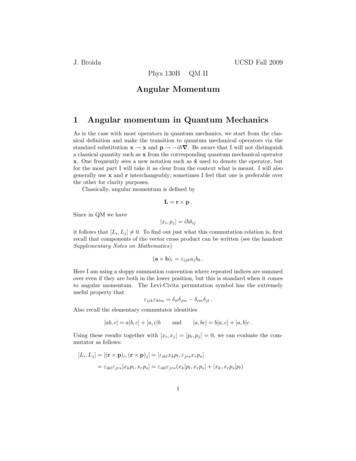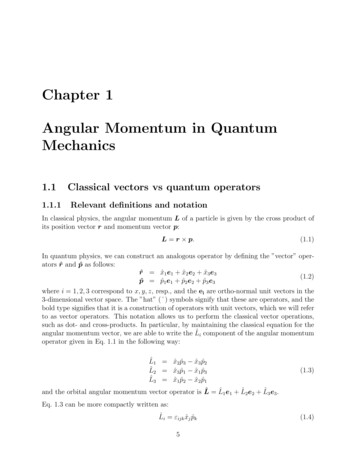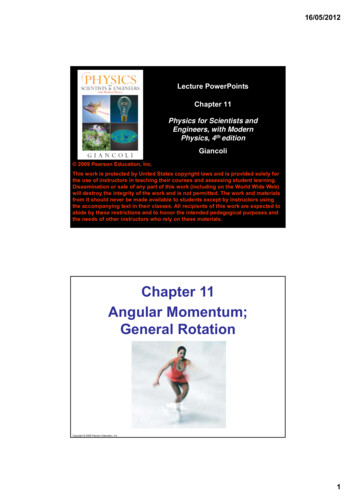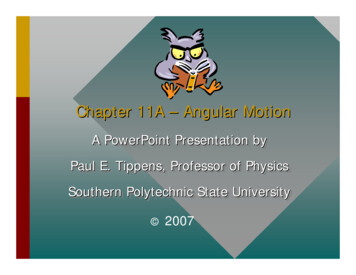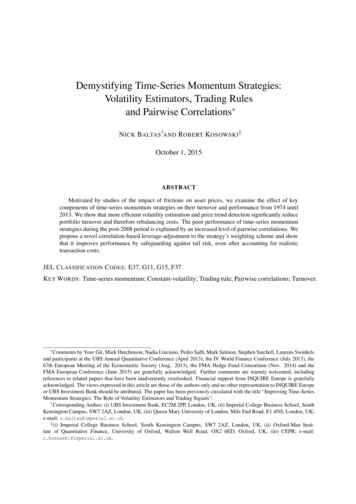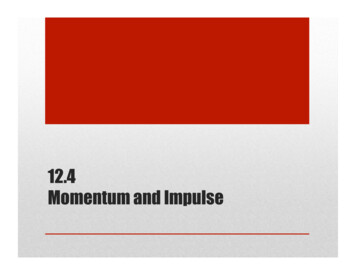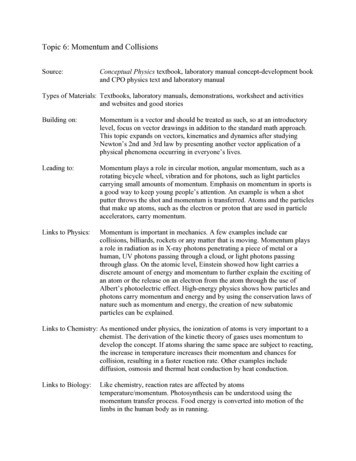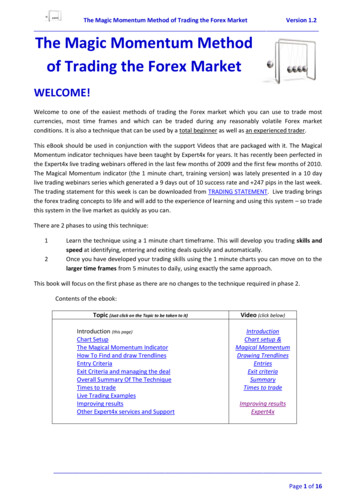
Transcription
Chapter 2Angular Momentum, HydrogenAtom, and Helium AtomContents2.1 Angular momenta and their addition . . . . . . . . . . . . . . . . . .242.2 Hydrogenlike atoms . . . . . . . . . . . . . . . . . . . . . . . . . . . . . . . . . . .382.3 Pauli principle, Hund’s rules, and periodical table . . . . . 422.4 Ground state of helium atom: 1st approximation . . . . . .48Basic QuestionsA. What are the eigenvalues of angular momentum operator?B. What are the quantum numbers of a state of the singleelectron in hydrogen atom?C. What is total electron spin of ground-state helium atom,and the spin eigenstate?23
24CHAPTER 2. ANGULAR MOMENTUM, HYDROGEN ATOM, AND HELIUM ATOM2.12.1.1Angular momentum and addition of two angular momentaSchrödinger Equation in 3DConsider the Hamiltonian of a particle of mass m in a central potential V (r)Ĥ h̄2 2 V (r) .2mSince V (r) depends on r only, it is natural to express 2 in terms of sphericalcoordinates (r, θ, ϕ) as 1 r2 2r r r2!1 2sin θr sin θ θ θ! 1 2.r 2 sin2 θ ϕ2Operators in Spherical CoordinatesA. Laplacian operatorBy coordinate transformation between Cartesian (x, y, z) and spherical coordinates (r, θ, ϕ)x r sin θ cos ϕ,y r sin θ sin ϕ,z r cos θ,r qx2 y 2 z 2x2 y 2z2ytan ϕ xtan2 θ we have r r r sin θ cos ϕ, sin θ sin ϕ, cos θ x y z θ1 θ1 θ1 cos θ cos ϕ, cos θ sin ϕ, sin θ xr yr zr1 sin ϕ ϕ1 cos ϕ ϕ ϕ , , 0. xr sin θ yr sin θ zUsing the derivative rule r θ ϕ x x r x θ x ϕ
2.1. ANGULAR MOMENTUM AND ADDITION OF TWO ANGULAR MOMENTA251 1 sin ϕ cos θ cos ϕ r r θ r sin θ ϕ 1 1 cos ϕ sin θ sin ϕ cos θ sin ϕ y r r θ r sin θ ϕ 1 cos θ sin θ z r r θ sin θ cos ϕTherefore 2 2 2 x2 y 2 z 2! 1 1 sin ϕ sin θ cos ϕ cos θ cos ϕ r r θ r sin θ ϕ! 1 1 sin ϕ sin θ cos ϕ cos θ cos ϕ r r θ r sin θ ϕ!1 1 cos ϕ sin θ sin ϕ cos θ sin ϕ r r θ r sin θ ϕ! 1 1 cos ϕ sin θ sin ϕ cos θ sin ϕ r r θ r sin θ ϕ!!1 1 cos θ sin θ cos θ sin θ r r θ r r θand this is equal to, after some considerable algebra 2 r 21 2r r1 2r r 2 with definition 2cot θ 1 212 2 22222r θr rr θr sin θ ϕ!! 21 1r2 2sin θ 2 2 rr sin θ θ θr sin θ ϕ2! 1r2 2  (θ, ϕ) rr 1 sin θ (θ, ϕ) sin θ θ θ! 1 2.sin2 θ ϕ2B. Angular momentum operatorsConsider first the z-component, using the above formulas forL̂z ih̄ x y y x xand y!1 1 cos ϕ ( ih̄) r sin θ cos ϕ sin θ sin ϕ cos θ sin ϕ r r θ r sin θ ϕ!
26CHAPTER 2. ANGULAR MOMENTUM, HYDROGEN ATOM, AND HELIUM ATOM 1 1 sin ϕ ( ih̄) r sin θ sin ϕ sin θ cos ϕ cos θ cos ϕ r r θ r sin θ ϕ ih̄ ϕ!similarly we can derive the x- and y-components asL̂xL̂y! ih̄ sin ϕ cot θ cos ϕ θ ϕ! ih̄ cos ϕ cot θ sin ϕ. θ ϕ¿From the definition of the raising and lowering operatorsL̂ L̂x iL̂yit is straightforward to obtain L̂ ih̄e iϕ i cot θ θ ϕ!.C. Angular momentum squareIn order to obtain the square of angular momentum operator in the spherical2coordinates, consider L̂x L̂x 2 h̄2 L̂y 2 h̄2!2 sin ϕ cot θ cos ϕ θ ϕ sin ϕ sin ϕ sin ϕ cot θ cos ϕ cot θ cos ϕsin ϕ θ θ θ ϕ ϕ θ cot θ cos ϕcot θ cos ϕ ϕ ϕ2 sin2 ϕ 2 sin ϕ cos ϕ cot θ cot θ cos2 ϕ θ θ ϕ θ2 2 cot θ cos ϕ sin ϕ cot2 θ cos ϕ sin ϕ cot2 θ cos2 ϕ 2 ϕ θ ϕ ϕ!2 cos ϕ cot θ sin ϕ θ ϕ 2 cot θ sin2 ϕ cos2 ϕ 2 sin ϕ cos ϕ cot θ θ θ ϕ θ2 2 cot θ cos ϕ sin ϕ cot2 θ sin ϕ cos ϕ cot2 θ sin2 ϕ 2 ϕ θ ϕ ϕ
2.1. ANGULAR MOMENTUM AND ADDITION OF TWO ANGULAR MOMENTA27now 2L̂2x L̂2y L̂2z L̂2 22 cotθ cotθ 1 θ 2 θ ϕ2 h̄2 h̄2 1 21 sin θ  (θ, ϕ) sin θ θ θ sin2 θ ϕ21 1 L̂2z sin θ sin θ θ θ sin2 θ h̄2where  (θ, φ) is as defined before in the Laplacian 2 .The Schrödinger eq. becomes h̄2 1 r2 22m r r r EΨ (r, θ, ϕ)"(or("!1 2sin θr sin θ θ θ h̄2 1 r2 22m r r r!!1 2 2 2 V (r) Ψ (r, θ, ϕ)r sin θ ϕ2#)L̂2Ψ (r, θ, ϕ) EΨ (r, θ, ϕ) . V (r) 2mr 2)#This eq. is separable. LetΨ (r, θ, ϕ) R (r) Y (θ, ϕ)where Y (θ, ϕ) is assumed to be the eigenstate of L̂2 with eigenvalue λL̂2 Y (θ, ϕ) λY (θ, ϕ)we have the equation for the radial part of wavefunction("h̄2 1 2 r2m r 2 r r!#)λ V (r) R (r) ER (r) .2mr 2The solution of this equation depends on the given potential V (r). But the solutionfor the angular part of wavefunction Y (θ, ϕ) is universal and can be discussed ingeneral.2.1.2Operators and their algebraClassically, angular momentum is defined asL r p
28CHAPTER 2. ANGULAR MOMENTUM, HYDROGEN ATOM, AND HELIUM ATOMor in component formLx ypz zpy ,Ly zpx xpz ,Lz xpy ypxL̂y ẑ p̂x x̂p̂z ,L̂z x̂p̂y ŷp̂x .in QM, they all become operatorL̂x ŷp̂z ẑ p̂y ,Their commutation relations are given byhL̂x , L̂yhhL̂y , L̂zL̂z , L̂xiii [ŷp̂z ẑ p̂y , ẑ p̂x x̂p̂z ] [ŷp̂z , ẑ p̂x ] [ẑ p̂y , x̂p̂z ] ŷ [p̂z , ẑ] p̂x [ẑ, p̂z ] p̂y x̂ ih̄ŷp̂x ih̄p̂y x̂ ih̄L̂z ih̄L̂x ih̄L̂ywe can memorize these relations byL̂ L̂ ih̄L̂ .In spherical coordinates, these operators are expressed asL̂xL̂yL̂z! ih̄ sin ϕ cot θ cos ϕ θ ϕ! ih̄ cos ϕ cot θ sin ϕ θ ϕ ih̄ ϕand2L̂ h̄21 1 2sin θ sin θ θ θ sin2 θ ϕ2!.Hence the Laplacian operator 2 and Hamiltonian take the following simple formL̂21 2 r r 2 r r h̄2 r 21 L̂2h̄2 1 2 r V(r) Ĥ 2m r 2 r r2m r 2 2
2.1. ANGULAR MOMENTUM AND ADDITION OF TWO ANGULAR MOMENTA29It is easy to see L̂z commutes with L̂2hiL̂z , L̂2 0and L̂2 commute with operators Ĥ ,hihhiL̂2 , Ĥ 0 .i(note: we also have L̂x , L̂2 L̂y , L̂2 0) Therefore we can find a wavefunctionwhich is eigenfunctions to both Ĥ, L̂2 , and L̂z . Furthermore, since they are separable,the eigenfunction of Ĥ can be written in general asΨn.l,m (r, θ, ϕ) Rnl (r) Θl (θ) Φm (ϕ) Rnl (r) Yl,m (θ, ϕ)with Φm (ϕ) λm Φm (ϕ) ϕ! λ2mh̄2 2sin θ Θl (θ) λl,m Θl (θ)L̂ Yl,m (θ, ϕ) λl,m Yl,m (θ, ϕ) sin θ θ θ sin2 θL̂z Φm (ϕ) λm Φm (ϕ) iĤΨn.l,m (r, θ, ϕ) λn,l,m Ψn.l,m (r, θ, ϕ)!1 λl,mh̄2 1 2 r V (r) Rnl (r) λn,l,m Rnl (r)2µ r 2 r r2µ r 2In Dirac notationΦm (ϕ) miYl,m (θ, ϕ) l, miΨn.l,m (r, θ, ϕ) n, l, mi .Instead of dealing with L̂x , L̂y , and L̂z , one can define angular raising and loweringoperators L̂ and L̂ as, L̂ L̂x iL̂y ih̄e iϕ i cot θ θ ϕ!and we have the equivalent set L̂x , L̂y , and L̂z or L̂ , L̂ and L̂z . The algebra forthis 2nd set is more convenient. It is easy to show the commutations between threeoperators Lz , L are given byhiL̂z , L̂ h̄L̂ ,hiL̂ , L̂ 2h̄L̂z .
30CHAPTER 2. ANGULAR MOMENTUM, HYDROGEN ATOM, AND HELIUM ATOMihNote: Compare this algebra with harmonic oscillator â, ↠1. These algebra willdetermine the eigenfunctions and eigenvalues of L̂2 . It is also easy to deriveL̂ L̂ L̂2 L̂2z h̄L̂z ,L̂ L̂ L̂2 L̂2z h̄L̂z ,andL̂2 L̂2z h̄L̂z L̂ L̂ L̂2z h̄L̂z L̂ L̂ L̂2z 1 L̂ L̂ L̂ L̂ .2 Note: compare this with harmonic oscillator Ĥ h̄ω ↠â 2.1.312 .Eigenvalues and eigenfunctions(i) Solution for Φm (ϕ) is simple ih̄ Φm (ϕ) λm Φm (ϕ) ϕ1Φm (ϕ) eiλm ϕ/h̄2πand using spherical symmetry of the system, we must haveΦm (ϕ 2π) Φm (ϕ) λm m 0, 1, 2, · · ·h̄thereforeL̂z mi mh̄ mi ,m 0, 1, 2, · · · .(ii) Consider the eigenequationsL̂2 l, mi λl,m l, miit is obvious l, mi is also eigenfunction of L̂zL̂z l, mi h̄m l, miwe next examine the effect of L̂ and L̂ when acting on l, mi. We divide the wholeprocess by following steps.hi(a) Using the commutation relationship L̂z , L̂ h̄L̂ , we have L̂z L̂ l, mi L̂ L̂z L̂ l, mi h̄mL̂ h̄L̂ l, mi h̄ (m 1) L̂ l, mi
2.1. ANGULAR MOMENTUM AND ADDITION OF TWO ANGULAR MOMENTA31therefore, L̂ effectively increases m by a unity and L̂ effectively decreases m by aunity, hence we writeL̂ l, mi C (l, m) l, m 1iwhere C (l, m) are constants. Therefore, the states l, mi with m 0, 1, 2, · · ·can be related by raising or lowering operator L̂ .(b) L̂2 degeneracy. The eigenvalue of L̂2 is independent of m, λl,m λlL̂2 l, mi λl l, mi .hiProof: using L̂2 , L̂ 0, we haveL̂2 L̂ l, mi C L̂2 l, m 1i λl,m 1 C l, m 1i λl,m 1 L̂ l, mi L̂ L̂2 l, mi λl,m L̂ l, mihenceλl,m 1 λl,m λl.(c) For a given λl (or l), the values of m must be bounded. BecauseD L̂2x L̂2y E 0, L̂2 L̂2x L̂2y L̂2z L̂2x L̂2y h̄2 m2 . Let this maximum value of m be Ml l,remember l is only an index for labeling. Hence l, mi ,m 0, 1, 2, · · ·, l .Altogether, there are (2l 1) values of m.(d) Consider state l, li. Since its m is at maximum, cannot increase any more,we must haveL̂ l, li 0henceL̂2 l, li L̂2z h̄L̂z L̂ L̂ l, li h̄2 l2 l l, li h̄2 l (l 1) l, li .Using the degeneracy of L̂2 , we haveL̂2 l, mi h̄2 l (l 1) l, mi ,m 0, 1, 2, · · ·, l .(e) We can now determine the coefficients C (l, m)L̂ l, mi C (l, m) l, m 1i .
32CHAPTER 2. ANGULAR MOMENTUM, HYDROGEN ATOM, AND HELIUM ATOM Using the fact that L̂ normalized, we have † L̂ , assuming l, mi and l, m 1i have already beenL̂ l, mi C (l, m) l, m 1iC 2 (l, m) hl, m L̂ L̂ l, mi hl, m L̂ L̂ l, mi hl, m L̂2 L̂2z h̄L̂z l, mi h̄2 [l (l 1) m (m 1)]orqC (l, m) h̄ l (l 1) m (m 1)similarlyqC (l, m) h̄ l (l 1) m (m 1) .(f) From the definition of L̂ in spherical coordinate L̂ ih̄eiϕ i cot θ θ ϕ!and using the fact thatL̂ l, li 0we derive the equation for the highest-order spherical harmonic function, l, li Yll (θ, φ)! l cot θ Yll 0, θYll c eilφ sinl θ,where c is the normalization constant, determined by2πZπ0sin2l 1Zθdθ 2π 4πZπ/20π/20 Zππ/2!sin2l 1sin2l 1 θdθ 4πvu( 1)l u (2l 1)!!c t(2l)!!4πθdθ 2πZπ/20sin2l 1θdθ Zπ/20cos2l 1(2l)!!.(2l 1)!!By applying L repeatedly, we obtain the general spherical harmonic, Ylm (θ, ϕ).(iii) For a general angular momentum L̂, all above derivations are still valid,except that we do not have the representation L̂z ih̄ / ϕ, etc. And the corresponding rotational invariance Φ (ϕ 2π) Φ (ϕ) m 0, 1, 2, · · · are hencenot necessarily true. Hence we derive the following general angular momentumtheorem,L̂2 l, mi h̄2 l (l 1) l, miL̂z l, mi h̄m l, mim l, l 1, · · ·, l 1, lθdθ!
2.1. ANGULAR MOMENTUM AND ADDITION OF TWO ANGULAR MOMENTA33with (2l 1) values of m. As 2l 1 must be an integer, l must be an integer orhalf-odd-integer.Example: Electron spin. An electron has an intrinsic angular momentum,called spin, denoted as Ŝ, with quantum number S. Experimentally, it was foundS 1/2. The corresponding z-component quantum number is therefore given bym 1/2, 1/2. Therefore, applying the above universal algebra to the spin angularmomentum, we haveŜ 2 S, mi h̄2 S (S 1) S, mi 21 1 1 S, mi h̄2 21 13 2h̄ S, mi , m , 42 2Ŝz S, mi h̄m S, mi .Since for an electron, S 1/2 is fixed and well-know, Ŝ 2 43 h̄2 is a constant. Wedenote m 21 as spin-up state, and m 21 as spin-down state, we write1 i χ ,S, m 2andŜz i 2.1.4h̄ i ,21S, m 2 i χ h̄Ŝz i i .2Addition of Angular MomentaWe know that the eigenstates of a general angular momentum L̂ has two quantumnumbers (qn): l - angular momentum qn and m - magnetic qn, the correspondingeigen eqs. areL̂2 l, mi h̄2 l (l 1) l, miL̂z l, mi h̄m l, mi , m l, l 1, · · ·, l 1, l .hiThe reason is simply that these two operators commute with one another L̂2 , L̂z 0. People usually refer these proper qn’s as good quantum numbers.Now we consider addition of two angular momentaL̂ L̂1 L̂2L̂2 L̂21 L̂22 2L̂1 · L̂2L̂1 · L̂2 L̂x1 L̂x2 L̂y1 L̂y2 L̂z1 L̂z2 .
34CHAPTER 2. ANGULAR MOMENTUM, HYDROGEN ATOM, AND HELIUM ATOMPhysical examples are the total angular momentum of two separate particles, or thetotal momentum of the orbital and spin angular momenta of a single particle, etc.The eigen states of L̂21 and L̂22 are known separately asL̂2i li , mi i h̄2 li (li 1) li , mi i , i 1, 2L̂zi li , mi i h̄mi li , mi i , mi li , li 1, · · ·, li 1, li .We want to know what are the good qn’s for the eigenstates of total L̂, and what arethe eigenvalues.The algebra for total L̂ is the same as before. It is easy to provehL̂2 , L̂21i hihiL̂2 , L̂22 L̂2 , L̂z 0L̂z L̂z1 L̂z2buthL̂2 , L̂z1hL̂2 , L̂z2i 2 L̂x1 L̂x2 L̂y1 L̂y2 , L̂z1hi 2 L̂x1 L̂x2 L̂y1 L̂y2 , L̂z2i 2ih̄ L̂y1 L̂x2 L̂x1 L̂y2 6 0hi 2ih̄ L̂x1 L̂y2 L̂y1 L̂x2 6 0 .Therefore, we can find a common eigen state to L̂21 , L̂22 , L̂2 , L̂z and denote as l1 , l2 , l, mi,these are good quantum numbers. (m1 and m2 are not good quantum numbers).The eigen eqs. areL̂21 l1 , l2 , l, miL̂21 l1 , l2 , l, miL̂2 l1 , l2 , l, miL̂z l1 , l2 , l, mi h̄2 l1 (l1 1) l1 , l2 , l, mih̄2 l2 (l2 1) l1 , l2 , l, mih̄2 l (l 1) l1 , l2 , l, mih̄m l1 , l2 , l, mi , m l, l 1, · · ·, l 1, letc.The question is: for a given l1 and l2 , what are the possible values for l. For thispurpose, we consider the following few steps:(a) Total dimensionality (no. of independent states) is (2l1 1) (2l2 1). Thiswill restrict the number of possible lXl(2l 1) (2l1 1) (2l2 1) .
2.1. ANGULAR MOMENTUM AND ADDITION OF TWO ANGULAR MOMENTA35(b) Starting with the state l1 , m1 l1 i l2 , m2 l2 iit is eigenstate of L̂zL̂z ( l1 , m1 l1 i l2 , m2 l2 i) h̄ (l1 l1 ) ( l1 , m1 l1 i l2 , m2 l2 i)and since m l1 l1 is the largest possible value for m, l l1 l1 is the largestpossible value for l. This is the only one. Hence l1 , l2 , l1 l1 , l1 l1 i l1 , l1 i l2 , l2 i(c) Next, consider state with m l1 l1 1. There are two possible l, withl l1 l1 and l l1 l1 1, hence denoted as l1 , l2 , l1 l1 , l1 l1 1i , l1 , l2 , l1 l1 1, m l1 l1 1iIn terms of l1 , m1 i l2 , m2 i representation, these are a linear combination of two possible states, as seen in the following tablem1l1l1l1
2.1 Angular momentum and addition of two an-gular momenta 2.1.1 Schr odinger Equation in 3D Consider the Hamiltonian of a particle of mass min a central potential V(r) H 2 h2 2m r V(r) : Since V(r) depends on r only, it is natural to express r2 in terms of spherical coordinates (r; ;’) as r2 1 r2 @ @r r2 @ @r ! 1 r2 sin @ @ sin @ @ ! 1 r2 sin2 @2 @’2: Operators in Spherical .
